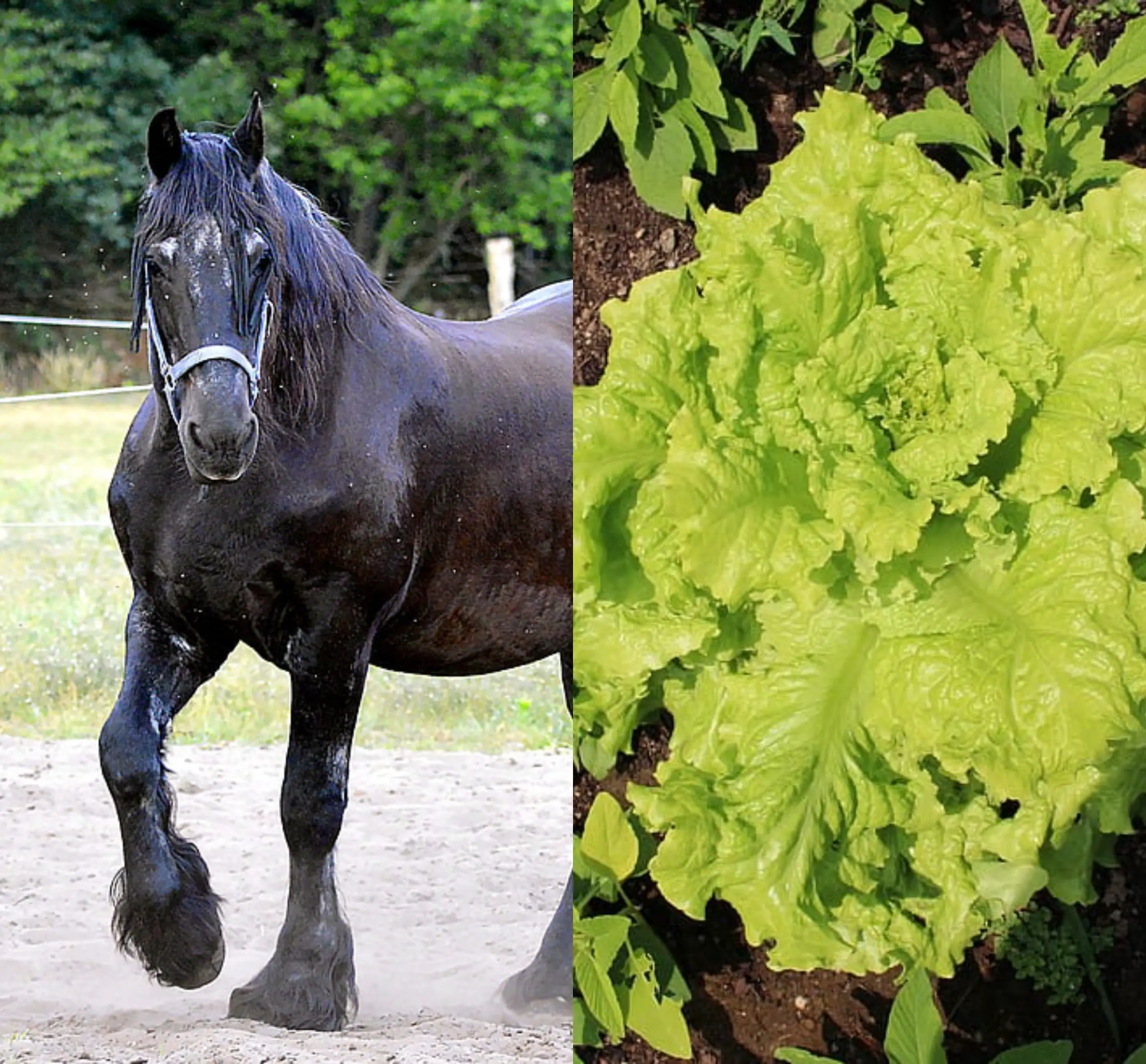Last Updated on May 26, 2020 by Allison Price
There is a wide variety of food our horses can enjoy. But some are not beneficial for their health so we have to be careful. Many horses would refuse to even sniff on some veggies and treats. That’s why it is important for horse owners to know which food is safe and cost-efficient.
When feeding your horses, it’s always better to commit to a daily feeding schedule. Use grass or hay for your horse’s diet. It is okay to give your horse a treat every now and then to praise them for good work or to cool them as a summer treat. It is best to check your horse if they are insulin resistant to avoid health issues. Before feeding, always cut other foods into smaller portions to prevent choking. Also if you give the wrong feeds, it may cause a lot of discomfort and pain to your horses. It can even damage their digestive and urinary system.
Here’s a quick review of lettuce.
People enjoy lettuce as it has good nutrients and perfect for one’s diet. Besides its taste and fresh texture, it is good for your pets including horses. But, it does not contain many minerals and vitamins. Like any other veggies and may not be enough for your horse’s diet. Also, some wild lettuce contains Lactucarium, a milk-colored liquid found when starched. This milky liquid’s identified as opium lettuce. This has toxins that are poisonous to other animals. Wild lettuce, also referred to as bitter lettuce, is a popular weed in Europe and some parts of the USA. In wild lettuce, the Lactuca virosa has some analgesic characteristics that are sedative.
Lactuca sativa is the scientific name for the edible lettuce. Unlike the wild lettuce, it does not have toxins. Iceberg lettuce is edible lettuce which contains a chemical called lactucin. Yet, it is a lactucarium element, it is not poisonous.
Some lettuce can also be harmful to smaller animals such as guinea pigs, hamsters, and even to our pet dogs. This is because of the presence of toxin Lactucarium. Edible lettuce or iceberg lettuce can cause diarrhea to animals. It makes them sick and can cause bloating which sometimes is fatal. Like any food stored too long from the fridge, lettuce may cause digestive problems. The same holds true for the leaves of wet lettuce. This can cause bloating to your pets. To be safe never feed any wilted or slimy animal lettuce to any animals.
So, can a horse eat lettuce?
Your horse is so big that eating small amounts of any lettuce won’t cause any harm. It takes a huge amount of wild lettuce to cause digestive difficulties to your pet horse. Thus, keep it in small quantities. Keep an eye on them for any changes in behavior that could signal a problem. Acceptable quantity will be at least 2 to 4 ounces per day.
REMEMBER.
Do not mix lettuce on other feeds other than their normal diet of hay, grain, and freshwater. Eating iceberg lettuce may sometimes cause bloating and diarrhea. Thus, watch for any behavioral changes. This may show that your horse is experiencing digestive problems.
Vegetables That Are Good for your Horses
- CARROTS. It is high in vitamin A (Carotene), low in saturated fat and cholesterol. To feed carrots to your horses, either cut the carrots lengthwise or cut it each into smaller pieces. Most horses love to eat carrots. But, like any other treats, do not feed them too many.
- CELERY. It contains vitamins such as Vitamin K, potassium, manganese, Vitamins B2, C, B6, and A. It is also a good source of fiber. Horses can eat both the celery stalk and the celery leaves. Like feeding any other vegetables to horses, cut the celery into smaller sized pieces.
- CORN. Most corn given to horses is either cracked or rolled. This is mixed with other grains or mixed feed. Corn is an excellent source of Potassium, Vitamin B-6, Magnesium, and Iron. Yet, corn is also very high in starch that can be problematic for a horse’s digestive system. But you can still feed your horses corn as part of its diet.
- PUMPKIN. Some horses enjoy the taste of it. Pumpkins are very high in Vitamin A. It made up of ninety percent water pumpkins and has a sweet taste. This is why some horses enjoy eating it. To feed horses pumpkin, take a pumpkin and slice a hole at the top. Scoop out the flesh and the seeds. Separate and remove the seeds. Cut the flesh into small chunks.
REMEMBER. ALL FOODS SHOULD BE FED IN MODERATION; OVER FEEDING YOUR HORSE MAY CAUSE UPSET TO A BALANCED DIET.
Vegetables that are not good for your horses.
These are the veggies you need to avoid feeding your horses. These foods can cause your horse health problems and can be fatal.
- Tomatoes. Tomatoes can cause constipation; they are a member of the toxic Solanaceae family. Tomatoes also contain hyoscyamine which decreases saliva production and increases heart rate.
- Garlic & Onions. Along with leeks, shallots, and chives, these are members of the allium family. They kill red blood cells.
- Chocolate. Chocolate contains theobromine that causes colic, seizure, metabolic derangements, and internal bleeding. It also contains caffeine which can cause horse’s failure in a drug test.
- Dairy Products. It’s best to avoid any dairy products as horses are lactose intolerant.
- Bread Products. Bread products can cause choking.
- Meat. Horses are herbivores. Their digestive systems are not designed to eat meat. These may have long term health side effects that we are unaware of.
- Rhubarb. Rhubarb can damage the digestive and urinary systems. These can then lead to kidney failure caused by the calcium oxalates that it contains in its leaves.
- Potatoes. If the potatoes are green or moldy they can cause toxicosis and if eaten whole they can cause choke.
- Brans. These can cause mineral imbalance and discourage digestion, leading to diarrhea.
- Cabbage, Broccoli & Cauliflower. These foods can all cause severe gas if eaten in large amounts.
- Stone Fruits. Stone fruits can cause your horse to choke.
- Avocado. The skin, Stone, and leaves are all poisonous to horses.
- Caffeine. If your horse competes, caffeine can result in your horse failing a drug test. It can also give rise to an irregular heartbeat.
- Lawn Clippings & Compost. This may cause your horse to choke, and may also contain poisonous plants.
Feeding Guidelines
There are three general guidelines one should adopt when feeding the horse.
1. Feed at least twice a day.
2. Feed in the same divided amounts.
3. Set a specific time for feeding at the same intervals.
Divide equally the horse’s total feed intake in a day to keep its diet. They should feed at the same time or close to the same time every day. Changes in feeding habits may cause issues with intestinal motility and blood flow. This increases the risk of colic. This occurs to horses that are in a stable or kept in a paddock.
You can decrease the risk of colic through the following:
- Keeping forage available at all times
- Feeding 2 to 3 smaller meals a day
- Feeding the horse in one feeding as little concentrates as possible.


